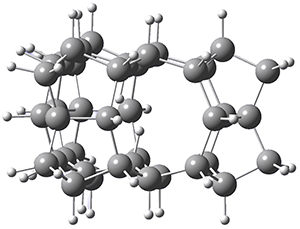Setting the record for the shortest non-bonded H…H contact has become an active contest. Following on the report of a contact distance of only 1.47 Å that I blogged about here, Firouzi and Shahbazian propose a series of related cage molecules with C-H bonds pointed into their interior.1 The compounds were optimized with a variety of computational methods, and many of them have H…H distances well below that of the previous record. The shortest distance is found in 1, shown in Figure 1. The H…H distance in 1 is predicted to be less than 1.2 Å with a variety of density functionals and moderate basis sets.
|
1 |
Figure 1. Optimized geometry of 1 at ωB97X-D/cc-pVDZ.
References
(1) Firouzi, R.; Shahbazian, S. "Seeking Extremes in Molecular Design: To What Extent May Two “Non-Bonded” Hydrogen Atoms be Squeezed in a Hydrocarbon?," ChemPhysChem 2016, 17, 51-54, DOI: 10.1002/cphc.201501002.
InChIs
1: InChI=1S/C41H44/c1-7-13-25-17-9-3-40-5-11-19(35(17)40)27-15-8-2-39(1,33(13)15)34-14(7)26-18-10-4-41-6-12-20(36(18)41)28(16(8)34)32(27)30-23(11)37(40)21(9)29(31(25)26)22(10)38(41)24(12)30/h7-38H,1-6H2
InChIKey=DMWSEJFKSWCSLI-UHFFFAOYSA-N


Fabio Pichierri responded on 28 Jan 2016 at 10:14 pm #
An interesting system indeed. In Figure 3 inside the paper the authors plotted the symmetric and asymmetric C-H stretching frequencies against the H:::H distances and obtained a quasi-linear relation (the correlation coefficient of the linear fitting was not reported). It would be interesting to calculate anharmonic C-H frequencies and plot them against the corresponding H:::H distances to check the role of anharmonicity of the molecular vibrations.
Another intriguing issue is to see whether the cage can force the H atoms to react with each other thus yielding H2:
C-H:::H-C => C. + H2 + .C
If the energy barrier of the above “piezochemical” reaction is not too high, then such “molecular compression chambers” (a term introduced by Baldridge and Siegel, see: J. Phys. Org. Chem. 2015, 28, 223) could be useful for the in-situ production of molecular H2.
Shant Shahbazian responded on 31 Jan 2016 at 10:09 am #
We have not done any regression and this is why no correlation coefficient has been reported in the paper. We also tried to reach to shorter distances but negative force constants were appeared. The idea of piezochemical reaction is indeed interesting and worth trying. By the way I am not sure whether it is possible to be realized experimentally.
Henry Rzepa responded on 13 Feb 2016 at 11:36 am #
Here are some QTAIM values on 1, optimised at the B3LYP+D3/Def2-TZVPP level (doi: 10.14469/ch/191885) for the close H…H contact.
1. ∇2ρ(r) = +0.300 (charge shift character)
2. ρ(r) 0.058 (a typical hydrogen bond)
3. Wiberg bond index +0.03 (very weakly bonded
4. QTAIM delocalisation index DI(A,B) 0.06 (very weakly bonded)
5. H…H distance 1.163A.
There is little evidence for incipient formation of H2. I have not investigated open shell solutions for this molecule (is the wavefunction stable to open shell solutions?).
Fabio Pichierri responded on 15 Feb 2016 at 8:51 pm #
Yes, I agree that there is little evidence for incipient formation of H2. However, we need to consider that the QTAIM results are concerned with the equilibrium geometry of 1 (at 0 K) whereas @RT the cage vibrations would bring the two H atoms at a closer distance. Also, some clever modification of the cage (e.g. chemical functionalization) might help to initiate the reaction.
Henry Rzepa responded on 16 Feb 2016 at 1:38 am #
Fabio,
At the B3LYP+D3/Def2-TZVPP level, the wavefunction is indeed stable to open shells by some margin (3.000-A’ Eigenvalue= 0.2029093, 1.000-A’ Eigenvalue= 0.2059491, doi: 10042/196145).
I would imagine that the two C-H vibrations must indeed be highly anharmonic as you suggest, but @RT seems unlikely to access the biradical states given their energies above?
Fabio Pichierri responded on 16 Feb 2016 at 9:12 pm #
Henry,
nice that you computed the stability of the WFN to open shell solutions (unfortunately I cannot access the link doi:…).
I wonder whether the energy of the biradical states could be lowered by modifying the system. Another possibility would be using a magnetic field to shift the S-T population.
Cheers.